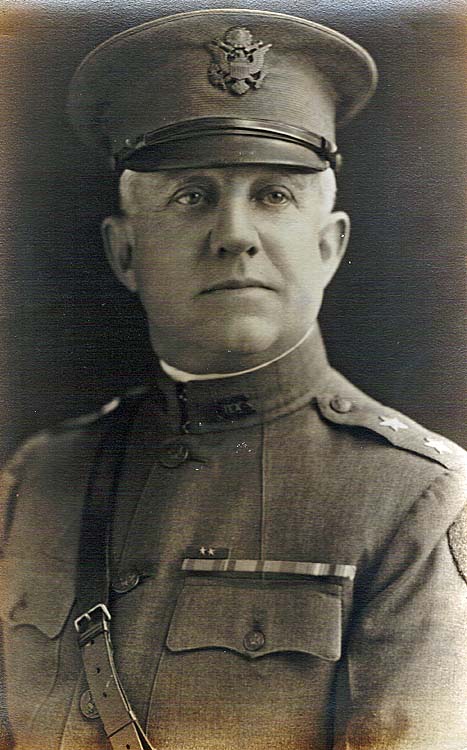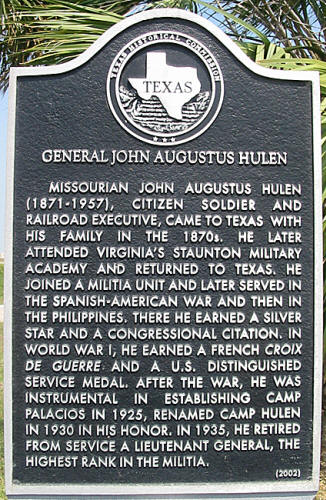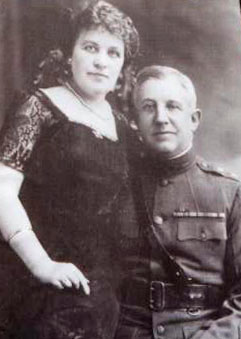|
|
||
|
||
|
|
||
|
General John Augustus Hulen made an indelible impression on the coastal town of Palacios, Texas, as Camp Hulen, situated on Tres Palacios Bay was named for him and Palacios was where he spent his final years in his summer home overlooking Palacios Bay and across the road from the site of Camp Hulen. Hulen’s home, now the headquarters of the Texas State Marine Education Center, touches many young people’s lives through its Aquiculture Educational program. John Augustus Hulen, born in Centralia, Boone County, Missouri, on September 9, 1871, was the son of Harvey Hulen and Frances Mary Morter Hulen. By 1874 his family was living in Gainesville, Texas. John Hulen was educated in the public schools of Gainesville. He also attended Staunton Military Academy (1887-89) in Virginia and Marmaduke Military Academy (1889-1891) in Sweet Springs, Missouri.
In 1893, because the horse troops were the troops used where trouble flared, he transferred to the cavalry, and was commissioned a captain of Troop D, First Texas Cavalry. He rose to major of the First, and went with the regiment when it was called for service as the “First Texas Cavalry, United States Volunteers,” in the Spanish-American War. He was promoted to the rank of Lieutenant Colonel in command of the regiment, leading it into action in Cuba and mustering the regiment out in 1899.
John Hulen was mustered out of the service in 1901 and was appointed Adjutant General of Texas by Governor S. W. T. Lanham, with the rank of Brigadier General. He served in that capacity from June 1903, until November 1907. In 1907, he was appointed Passenger Agent of the St. Louis and San Francisco Railroad Lines in Houston and in 1910 he worked for Trinity and Brazos Valley Railroad and became president of the company. After the line became the Burlington-Rock Island Railroad, he served as chairman of the board. As a founder of the National Bank of Commerce of Houston, he served that bank as vice president from 1914-1918. He was also a member of the Board of Directors of the Bank of the Southwest in Houston. Recalled to active service to a command position of the Texas National Guard, John Hulen served on the Mexican-American border, and was released from active federal service in 1917. He participated in the mobilization of the Texas National Guard for service in World War I. He commanded a brigade in France during that War. As a commander of The Texas National Guard, he organized the guard into the 36th “T-Arrow” division and commanded the 72nd Infantry Brigade of the Division in 1919 and retired with the rank of Lieutenant General. General Hulen was instrumental in locating Camp Palacios on the Texas Gulf Coast in 1925 and was in command of the Division until his retirement in 1935. Camp Palacios was the home of the division and in honor of the commander the name of the camp was changed to “Camp Hulen” September 11, 1930 by the War Department. General Hulen considered the campsite near Palacios, an ideal spot for maneuvering troops because of its thinly populated countryside. Also, because Camp Mabry, near Austin was too costly to expand since the price of land near Austin was much higher to buy. The Camp Palacios site was selected largely because the citizens of the coastal town donated large tracts of land to get the camp at Palacios. As he unloaded his twenty train loads of troops and set up camp in the summer of 1925, he often remarked, “I do enjoy the cool Gulf Breeze.” Hulen’s bravery in action won him The French Croix de Guerra twice, the Silver Star, the United States Distinguished Service Medal and was cited by Congress for heroism in action during his military career. Major General John A. Hulen, retired September 19, 1935 from the command of the 36th Division Texas National Guard and reviewed his Division for the last time at Camp Hulen. People of the local area and the state, led by the Governor of Texas, James V. Allred and his staff, attended the review to pay tribute and a mark of appreciation of General Hulen’s distinguished service not only to the 36th Division, but also to the entire State of Texas. His retirement marked 45 years of service in the military forces of the United States. Not only in service for his country but from 1931 through World War II, Hulen served on the home front as a director of Texas Technological College (now Texas Tech University) from 1931-1937, on the Texas Centennial Commission in 1935-36, and as president of the Railway Managers Association of Texas. Hulen was a delegate to the Democratic National Convention in 1932, and in 1941 President Franklin D. Roosevelt appointed him regional salvage manager of War Production Board, a ceremonial post that he held throughout World War II. In 1951, in celebration of Hulen’s 80th birthday, Don Hinga, a reporter for the Houston Chronicle interviewed the old general as he sat on the porch of his Palacios home and looked out at the Tres Palacios Bay. Hinga asked, “General, this country is in one hell of a shape. We are confronted with all sorts of international problems and as an old warrior, what would you suggest?”
The general turned around and said, “would you like to have a drink?’
The home overlooking Palacios Bay and across the road from the former site of Camp Hulen was General Hulen’s home for the last years of his life. Deed Records show that John A. Hulen purchased the 13.57 acres from Opal D. Price, June 26, 1940. The CTC Development News dated March/April 1996 notes that “Hulen stayed near military life building a home in Palacios near Camp Hulen following the death of this wife, Frankie, in 1941.”
The property was sold after Hulen’s death in 1959 to Lester Settegast who sold the property to Navigation District #1, Matagorda County in 1982. In 1986, the Palacios Independent School District leased the property from the Navigation District and under the guidance of Superintendent Bill Reeves and Vocational Director Leon Bullock expanded to include a history making Marine Educational Program. The restored home of General John A. Hulen was converted into offices and a meeting room for the Marine Center. The 36th Division Association furnished a room in the Marine Center (General Hulen’s home) with artifacts of the Division depicting the history of the Division, its commander and accomplishments, with pictures of the Division during the 1920s and 1930s, battle flags, battle streamers, uniform changes, battle engagements, weapons (including Enfield, Springfield & Garand Rifles) are on display. A large photograph of General Hulen in Battle Dress of WWI graces the wall above the fireplace in the reception room of the center. The formal opening of the Center and General Hulen’s home as the Marine Center was held on Monday March 19, 1990.
Hulen served under General Charles MacArthur and his
son, General Douglas MacArthur. He was a trusted General under “Black
Jack” Pershing. He was one solder who saw the U. S. Army switch from
muzzle-loading muskets to Garands and bazookas, from horse cavalry to
mechanized cavalry, from Pancho Villa raising a ruckus along the border
to the Korean War from his Tres Palacios Bay home “across the road” from
the site of Camp Hulen. Hulen died at his home on Palacios Bay on
September 14, 1957, and was buried in Forest Park Cemetery in Houston. |
||
Lt. Gen. John A. Hulen, organizer of the famed 36th
"T-Arrow" Division Texas National Guards and for whom Camp Hulen was
named, died at his home adjacent to the camp early Saturday morning. |
||
|
Palacios, Aug. 16.--Major General John Augustus Hulen and his "boys"--the 8000 officers and enlisted men of the Thirty-sixth division, Texas National Guard--meet officially on the parade ground for the last time this, Friday, afternoon at Camp Hulen near Palacios. The occasion was a review of the division honoring General Hulen, who will retire September 9, after 45 years of distinguished service in the Texas National Guard and the regular army, during which he rose from a private in the militia to the command of the largest national guard unit of the United States. Among the ranks of the guardsmen as they marched past and in the reviewing stand with General Hulen were many who were his comrades in arms in two wars on foreign soils--the Philippine insurrection and the World War. A large percentage of the officers of the division, and many of the noncommissioned officers, served with the unit when General Hulen, commanding the Seventy-second infantry brigade, led them in the Meuse-Argonne and Champagne battles, where his daring earned him the title of the "nearest to the front general: in the American expeditionary forces and won him the Distinguished Service medal and the Croix de Guerre. In the reviewing stand was a distinguished group of guests, headed by Governor James V. Allred. Included in the assembly were high army and governmental officials, former national guard officers and friends of the general. Born in Centralia, Mo., in 1871, General Hulen moved to Texas with his family at the age of three. He attended the public schools at Gainesville and had his first taste of military life at Staunton military academy, Staunton, Va., and later at Marmaduke military academy, Sweet Springs, Mo. He returned to Texas and enlisted as a private in the Gainesville Rifles of the old Texas National Guard and rose step by step through the ranks finally winning his commission as a second lieutenant. He had risen to a major in the guard when the Spanish-American war broke out and was promoted to lieutenant colonel of the old First Texas cavalry and ordered to the Mexican border. In 1899, when the famous Thirty-third volunteer infantry regiment was organized at San Antonio, he applied for a transfer to that unit because it was scheduled to go to the Philippines. In order to get into the regiment he accepted a commission as a captain, stepping down two ranks in his desire to see active service. Once in the Philippines the unit had all the fighting it was seeking. As a part of the division commanded by Major General Lawton, the Thirty-third fought its way up from Manila to Linayen Bay, 150 miles up the coast of the Island of Luzon, in pursuit of the insurrectionist leader, Aguinaldo. Takes Park in Battle At the battle of San Jacinto, bloodiest of the encounters between the American and the insurrectionists, General Hulen's outfit was in the advance guard of the army. In the skirmishes which followed, Captain Hulen's company captured a group of prisoners, including the five-year-old son of Aguinaldo, his mother and numerous officers of the insurrectionist group. Captain Hulen again distinguished himself in the battle of Tiglapz a short time later and when Lieutenant Guilmore, U. S. N., and a party of 22 sailors shipwrecked on the shore were captured by the insurgents, he was placed in command of a unit of the rescue expedition under General Young. As a result of personal bravery during the campaign he was recommended for the medal of honor and brevetted a major. After being mustered out of service he returned to Texas and in 1907 accepted the post of commercial agent for the St. Louis-San Francisco railway, with headquarters in Houston. A year later he formed a similar connection with the Chicago, Rock Island and Pacific railroad. Later he was made general passenger and freight agent for the Trinity and Brazos Valley railroad and served in that post until the United States entered the World War in 1917. He helped organize the Texas and Oklahoma national guard division and went overseas as commander of the Seventy-second brigade. Commanded Brigade His unit was a part of the Thirty-second division, with the Fourth French army, which won praise for its advance of 23 kilometers in one week during the Meuse-Argonne campaign. As commander of an infantry brigade in actual combat during the World War, General Hulen had under his personal direction on a battlefield more troops than ever commanded by any other Texan, according to Major General Jacob F. Wolters, retired. None of the Confederate generals from Texas, according to General Wolters, ever commanded on the field of battle as many as the 8000 troops which comprised an infantry brigade during the World War. After the World War General Hulen returned to Houston and resume his railroad duties. In 1921 he was commissioned a major general and set about reorganizing the Thirty-sixth division as a strictly Texas unit of the national defense. Since 1926 the division has staged its annual field training at Camp Hulen built by the federal government near Palacios and named in honor of the general. Troops Ranked High Under General Hulen's direction the guard division has progressed until it is recognized throughout military circles of the nation as the "crack" division of the militia. The division training is kept at such a high state that it could, as a unit, take the field for active service on instant notice. The division review will begin at 2 p. m. Friday. Many visitors will arrive earlier in the day to inspect the camp and training activities. The Southern Pacific Lines will run a special train from Houston direct to the camp. The train will depart from Houston at 8 a. m. Friday and leave Palacios at _:45 p. m. The special train will be air conditioned and will make connections at Houston on its return with trains for all parts of the state.
Daily Tribune, August 16, 1935 |


 On February 14, 1893, John Hulen married Frances
“Frankie” L. Race. They became “Frankie and Johnny” to the family. John
A. Hulen began his long and distinguished military career as a Private
in the Gainesville Rifles in 1889. Commissioned in 1891, he served as a
Lieutenant with Company G, 3rd Texas Volunteers Cavalry. An account of
his military service was reported on the news of his death in the
Houston Chronicle, September 14, 1957:
On February 14, 1893, John Hulen married Frances
“Frankie” L. Race. They became “Frankie and Johnny” to the family. John
A. Hulen began his long and distinguished military career as a Private
in the Gainesville Rifles in 1889. Commissioned in 1891, he served as a
Lieutenant with Company G, 3rd Texas Volunteers Cavalry. An account of
his military service was reported on the news of his death in the
Houston Chronicle, September 14, 1957: